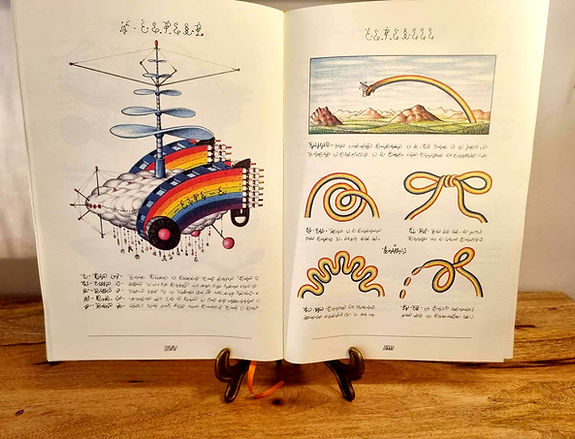Codex Seraphinianus
By: Luigi Serafini
Publisher: Rizzoli, Italy 2013 (first published in 1981 by F.M. Ricci)
Format: Hardcover


An mysterious encyclopedia of an imaginary world
I was first introduced to Codex Serpahinianus by Marcella Terrusi´s brilliant article about silent books. She calls it a mandatory historical reference that is so eccentric it is beyond any classification.
If you are not yet familiar with this work: Codex Seraphinianus resembles a giant encyclopedia. I wish I could tell you how many pages it consits of, but the page numbers, like all the writing, is asemic (an art form that fuses writing and image into a unity that has no semiotic meaning). So I don´t know the exact page number, but there are hundreds. The encyclopedia is from an imaginary world, filled with countless beautiful and bizzare illustrations. It is hard to give any exact description of what it is like, apart from saying that "reading" it is a truly enjoyable experience.
Inside the large book is a small pamplhet called "Decodex", where Serafini tells the very entertaining story of how Codex Seraphinianus came to be. He wanted to combine text and images in an encyclopedia of sorts, but could not decide in what language. Instead of choosing an existing language, he decided to recreate the experiences we have as children, when we leaf through picturebooks and pretend to read before we know how to. Thus, he created the asemic alphabet used in the encyclopedia.
The illustrations are stunning. They are very detailed, and there are so many stories to be read out of them, to see how they fit into this strange world and how they are connected. Like the image of a guy in rollerskates writing with a fountain pen that is also his right hand, only to be stabbed by a stylo in the next picture. Or the very fascinating page of a perforated rainbow and all the little creatures that live in it. There are pages that looks like instructions, other look like explanations. There are all kinds of weird and colorful plants, clothing and creatures. The asemic writing compliments the images perfectly, and it does give the feeling Serafini wanted, of being a child again, trying to make sense of signs that you can not yet read.
I think it is impossible to study silent books without at some point feeling the need to learn as much as possible about visual communication. It is easy to understand why Terrussi used this book as an example of a reference that is almost mandatory in that process. Codex Seraphianus opens up to so many forms of mediation, storytelling and wonder, and also to conversations about communication and language. The book is contradictory in so many ways - wordless, but not textless, it is an encyclopedia (a work that contains information), but the information is not readily available.
The wonderful artwork inside is complimented by a beutiful hardover, complete with gold lettering and emossed decoration. Leafing through the pages is made even more enjoyable because of the amazing paper quality. A work of art to treasure, a mystery that has already enchanted two generations.

